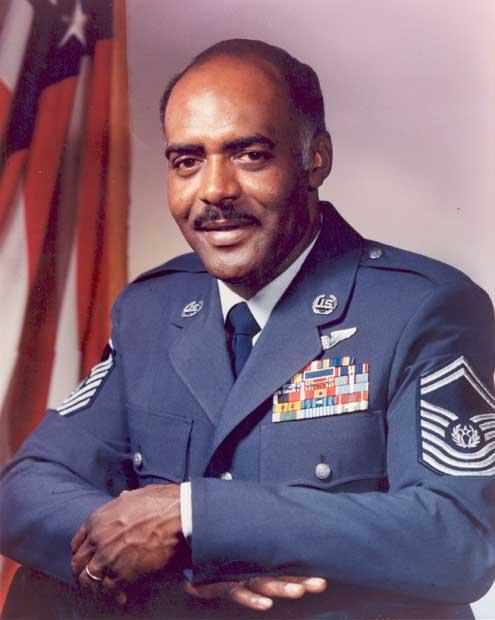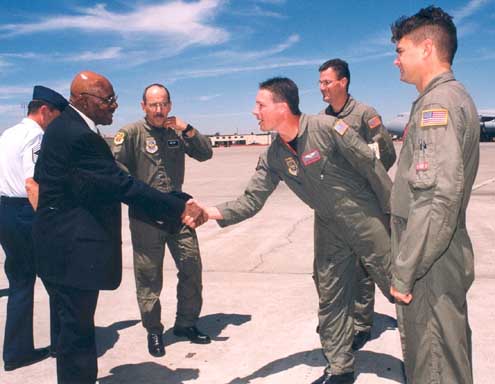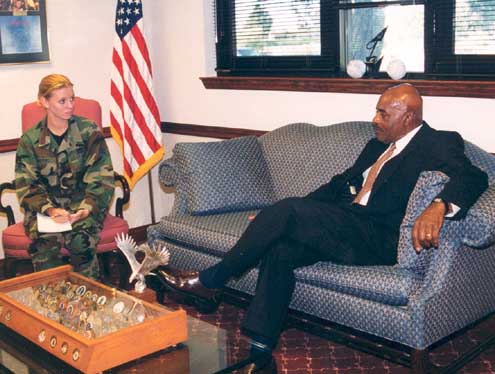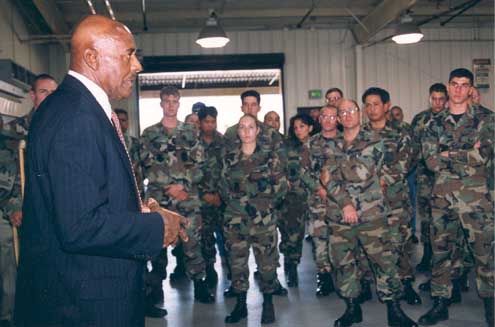"I always tried to convey the fact that I represented over 500,000 voters that might be crucial in the next election," Barnes commented. "Certainly if there is one thing Congress and the Senate understand, it is the power of the vote." Getting a large percentage of military personnel to vote was just another obstacle Thomas Barnes learned to deal with.
"We had to show military voters that at times political involvement could directly influence their pay and living conditions," Barnes told a friend years later. "Once they really understood that point, we formed a solid voting block."
Thomas Barnes learned much from his father, a baptist minister, and his mother, a school teacher. His father instilled in him a strong work ethic and reminded a young Thomas, "If you can't be on time, be early." His mother taught him to respect the differences in people, and growing up in Chester, Pennsylvania, in the late 1930s was an idyllic childhood; work was plentiful and everyone seemed to get along.
Chester was a thriving city with oil refineries, five steel plants and a ship yard. During the height of the World War ll, laborers poured into the area. A large percentage of the railroad workers were of Hispanic descent. The ship yards attracted a large contingency of Jamaican workers. Thomas was born in his family home in a neighborhood comprised of many ethnic groups. From the very beginning there was a need to fit into a very cross-cultured population.
Having worked some at the ship yard, Barnes began considering joining the Navy. He had friends in that branch of the service and, particularly since he had sailed on shakedown cruises to test the ships built locally, the Navy seemed the obvious choice. Fate intervened, though. Actually, Barnes eventually enlisted in the Navy, but on the day he was to report to the Great Lakes Naval Training Center he ended up in the hospital with strep throat. Upon his release from the hospital, he was informed that the Navy's training cadre for that period had already been filled. Too restless to wait, Barnes headed to the local post office and an Air Force recruiter. The recruiter knew a good man when he saw one, and Barnes was soon on his way to Lackland Air Force Base and basic training in San Antonio, Texas.
Having grown up in a harmonious community made up of various cultures and after a childhood in a loving home that taught appreciation of diverse backgrounds, it was a shock to find the Air Force segregated. Barnes had enlisted with a mixed group, leaving out of the Schukil Arsenal in Philadelphia for the long train ride to Texas. It was a harsh eye-opener to be separated from this group once the train pulled into the depot in San Antonio.
After basic training, technical training came next and Barnes was sent to Chanute AFB in Rantoul, Illinois to study hydraulics and aircraft engine mechanics. An assignment to Camp Stoneman in Pittsburgh, California followed tech school. The Air Force was learning lessons as well. The year was 1949 and President Harry Truman signed an order abolishing segregation in the military. It took time, but slowly the military came to understand that equality best served its mission. Barnes next assignment was to McChord AFB in Washington and this move presented the challenges that went along with joining a unit that had previously been entirely Caucasian. During this trying period, Barnes drew strength from the lessons he had been received as a child, when he had been taught not to just "tolerate" the differences in people, but to respect those differences. Having been blessed with a family that realized it was a necessity to understand each other and after growing up in a city where all groups coexisted peacefully, Barnes grasped the importance of harmony if everyone was to achieve a common goal.
"That has been an unwavering goal for me," Barnes states, "from that day until now."
As he progressed in his career from an aircraft engine mechanic to a position in charge of maintenance control of the B-52 bomber bases in Maine and Washington state, a trend developed; not only was it important to perform at a high level, it was just as important to assist his fellow airmen.
After an extensive overseas stint during the Vietnam conflict, Barnes found himself in a training command as the maintenance superintendent for the T-38 training jet flight line at Laughlin AFB in Del Rio, Texas. It was during the assignment at Laughlin that Barnes began being recognized for his outstanding performance. At first, the award was "Airman of the Year" at Laughlin AFB. Next he became "Airman of the Year" for the entire Air Force. By 1971, he had progressed to become Senior Enlisted Advisor to the Commander of the Air Training Command. Demonstrating an intrinsic ability to communicate and solve problems at many levels, Barnes was soon selected for the very prestigious position of Master Sergeant of the Air Force.

This is the official photograph taken when Thomas Barnes was selected as Chief Master Sergeant of the Air Force.
To say this new challenge had extensive travel requirements would be an understatement. It was estimated that Barnes covered as many as 265,000 miles per year. A visit to the European bases would begin with a flight into Heathroe Airport in London, England and Barnes was escorted from there to Lakenheath AFB and the other English bases. Then he was back in the air, flying to Germany. Landing at Ramstein AFB, Barnes would be driven to all of the U.S. installations in Germany. Then it was off to Holland, Italy, Spain, Greece and Turkey. A visit to the Pacific region would follow. There were also two major bases in Alaska, as well as several other sites to visit there.
The Air Force Chief of Staff that helped guide Barnes' selection as the Chief Master Sergeant of the Air Force was an extremely capable military strategist, General George S. Brown. General Brown confided to Barnes: "It will be better for you to travel alone in most instances, although at times it will be advantageous for us to stand together on an issue. I will make my support known through our meetings with the Air Force General Officers."
Before visiting every base, Barnes would review the Inspector General's report to identify specific issues that had been a previous concern at that location. As policy was being developed, the Chief Master Sergeant of the Air Force was not only part of that process, his input was crucial when it came time to review the implementation of that policy. As the voice of over half a million airmen, his perspective was invaluable to the Chief of Staff.
"One key element to the job," Barnes said he learned quickly, "was that you never went to the Chief and brought his attention to a problem without giving him a recommended solution and the reasoning behind why your solution would work. My presentations were thorough because the Chief of Staff already had enough problems without me handing him difficult decisions without possible solutions."
During his 28 year career, Thomas Barnes held a number of distinguished positions. He flew for nine years as a flight engineer on a variety of aircraft, seeing duty in Korea, the Cuban missle crisis and Vietnam and earning distinctive decorations for courage and leadership in a number of tense international situations. His major awards and decorations include the Legion of Merit, Meritorious Service Medal with one oak leaf cluster, the Air Medal, Air Force Commendation Medal and Outstanding Airman of the Year Award. So impressive were Mr. Barnes contributions that at McConnell Air Force Base a new training building was named in his honor. The Thomas N. Barnes Career Education Center will forever be a monument to one man's dedication to his country and to his compassion for his fellow man.
Following his retirement from the Air Force, Mr. Barnes worked at the First National Bank of Fort Wort as an Employee Relations Officer for seven years. He was then hired by the Associates Corporation of North America and promoted to Vice President/Director of Employee Relations at the Corporate headquarters in Las Colinas.
After retiring to Fannin County, Mr. Barnes' name still comes up regularly. For two years in a row he won the team penning at the Kueckelhan Rodeo, teaming up with Ronnie Sudderth and Howard Bachest the first year and working with Sudderth and Jimmy Kerr the second year. Mr. Barnes and his lovely wife Marie also raise Longhorn cattle.
People around Bonham will tell you that as notable as his past has been, nothing could be more impressive than the positive leadership Thomas Barnes has graced us with during his stay here in North Texas.

Mr. Barnes greets pilots on one of his many trips.

Thomas Barnes visits with a reporter during one of his visits.

Mr. Barnes addresses a crowd.